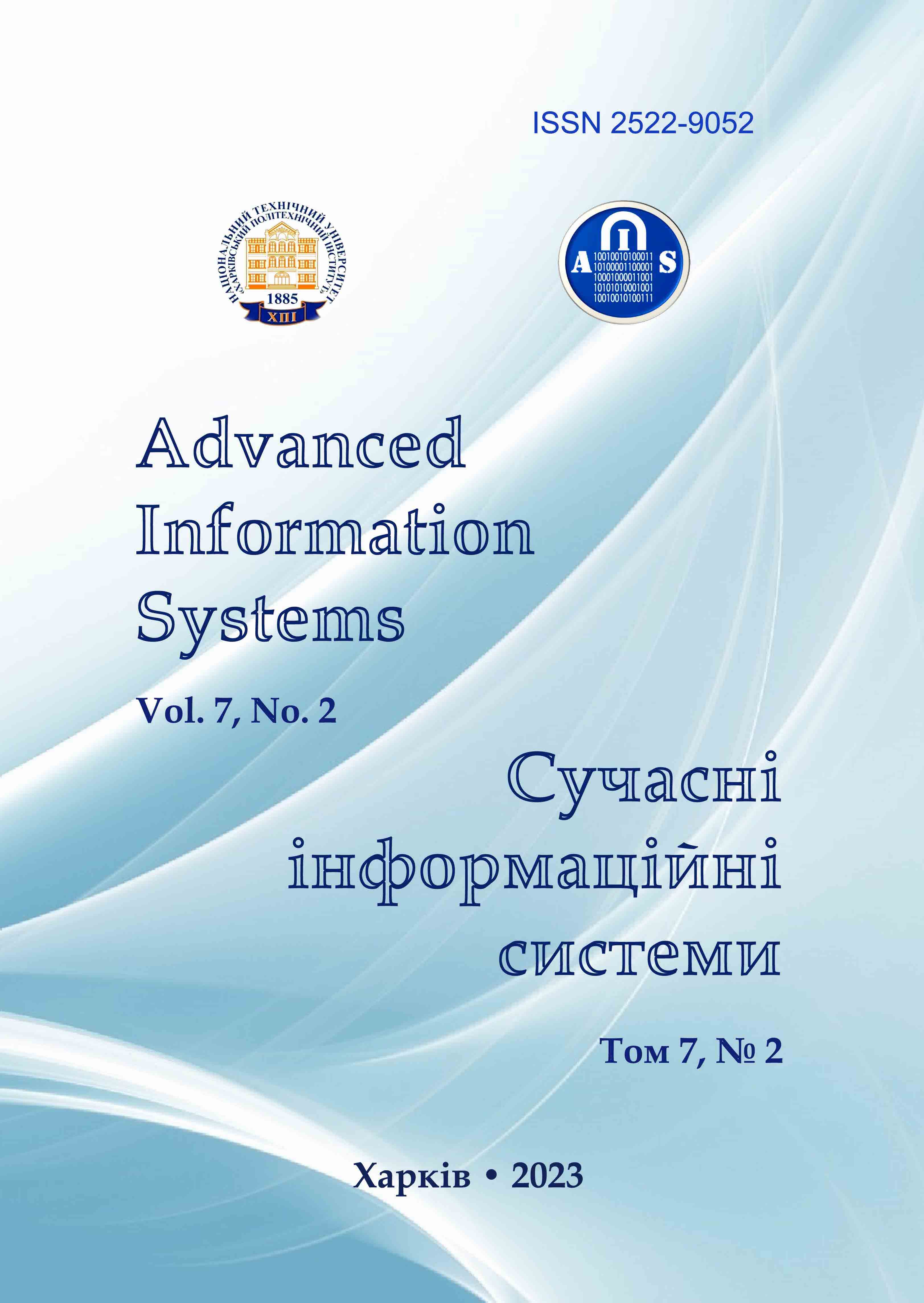Synthesis of quasi-optimal fast filters by the least square criterion
Main Article Content
Abstract
The subject of the article research is special signal processing methods based on the optimal discrete filtering theory. The goal is to increase the efficiency of model-based methods for processing information signals by reducing computational costs and increasing the speed of optimal discrete filtering algorithms. Applied methods: description of dynamic processes in terms of state space using elements of vector-matrix algebra, weighted least squares method, elements of Kalman's theory of optimal discrete filtering, basic concepts of the O'Reilly–Luenberger theory of functional observers, elements of probability theory, statistical modeling by the Monte Carlo method. Results: a new method for reducing computational costs is proposed, which uses the approximation of the Kalman filter transfer matrix time dependence by given piecewise linear functions according to the least squares criterion. The effectiveness of the method was evaluated on the example of a second-order dynamical system. On the basis of a comparative analysis, several acceptable variants of the considered approximation are proposed. The practical significance of the work lies in the further development of methods for the synthesis of quasi-optimal high-speed filters. The operability of the proposed modifications is confirmed by the example of a second-order linear dynamic system. The efficiency of the algorithms was evaluated by the statistical modeling method according to the criterion "accuracy-computational costs". It is shown that the total savings in the number of multiplication and addition operations can reach tens of times due to insignificant losses in the accuracy of the filtering process.
Article Details
References
Bozic, S.M. (2018), Digital & Kalman Filtering. An Introduction to Discrete-Time Filtering & Optimum Linear Estimation, Dover publications, INC: Mineola, New York, 240 p.
Chui, C. (2018), Kalman Filtering: with Real-Time Applications, Springer; Softcover reprint of the original 5th ed. 265 p.
Calin, O. (2021), Informal Introduction To Stochastic Calculus With Applications, WSPC; 2nd edition, 510 p.
Davis, B. and Blair, W. (2018), "Maximum likelihood mixture modeling for three-dimensional non-Gaussian meas-urements", IEEE Radar Conference, Oklahoma City, OK, USA, pp. 1027-1032, doi: https://doi.org/10.1109/RADAR.2018.8378702.
Gakis, G. and Smith, M. A (2022), "Deterministic Least Squares Approach for Simultaneous Input and State Estima-tion", IEEE Transactions on Automatic Control, pp. 1 – 16, doi: https://doi.org/10.1109/TAC.2022.3209415.
Yang, J.N., Pan, S. and Huang, H. (2007), "Anadaptive extended Kalman filter for structural damage identifications. II: Unknown inputs". Structural Control and Health Monitoring 14, рр. 497–521, doi: https://doi.org/10.1002/stc.171.
7.O'Reilly, J. (2007), Observers for Linear Systems, Academic Press, 258 p.
Krasnova, S.A. and Utkyn, V.A. (2006), Kaskadnyi syntez nabliudatelei sostoianyia dynamycheskykh system, [Cas-cade Synthesis of Dynamical Systems State Observers] Yn-t problem upravlenyia ym. V.A. Trapeznykova. RAN, Nau-ka, 272 p.
Alouani, A.T., Rice, T.R and Blair, W.D. (2007), "A two-stage filter for state estimation in the presence of dynamical stochastic bias", Proceedings of the American Control Cjnference, Chicago, IL, pp. 1784–88. doi: https://doi.org/10.23919/ACC.1992.4792418.
Volovyk, A.Yu., Kychak, V.M. and Havrilov, D.V. (2021), "Discrete Kalman Filter Invariant to Perturbations". Acta Polytechnica Hungarica, Vol. 18, No. 10, pp. 21-41, doi: https://doi.org/10.12700/APH.18.10.2021.10.2.
Volovyk, A., Kychak, V., Osadchuk, A., Zhurakovskyi, B. (2023). "Fault Identification in Linear Dynamic Systems by the Method of Locally Optimal Separate Estimation", Emerging Networking in the Digital Transformation Age. TCSET 2022. Lecture Notes in Electrical Engineering, vol 965. Springer, Cham., pp.634-651, doi: https://doi.org/10.1007/978-3-031-24963-1_37.
Marelli, D., Sui, T. and Fu, M. (2021), "Distributed Kalman estimation with decoupled local filters", Automatica, Vol.132, 109793, doi: https://doi.org/10.1016/j.automatica.2021.109724.
Hsieh, C.S. (2007), "Extension of the robust two-stage Kalman filtering for systems with unknown inputs", TENCON 2007, IEEE Region 10 Conference, Taipei, Taiwan, pp. 1-4, doi: https://doi.org/10.1109/TENCON.2007.4429133.
Syromiatnykov, R.F. (1975), "Yssledovanye pomekhoustoichyvosty alhorytmov mnohokanalnoho yzmerytelia dal-nosty v systeme avtomatyzyrovannoho upravlenyia poletamy", [Investigation of the noise immunity of algorithms for a multi-channel range meter in an automated flight control system], Kand. Dissertation, LETY, 251p.
Avtin, I. V., Baburov, V. I., and Ponomarenko, B. V. (2021), Principles of Integrated Airborne Avionics, Springer Aerospace Technology, Springer; 1st ed., 719 p.
Henningsson, T. (2007), "Recursive state estimation for linear systems with mixed stochastic and set-bounded dis-turbances", 47th IEEE Conference on Decision and Control, Cancun, Mexico, 2008, pp. 678-683, doi: https://doi.org/10.1109/CDC.2008.4739139.
Kychak, V.M., Volovyk, A.Iu and Volovyk, Yu. (2011), Metody ta prystroi obrobky radiosyhnaliv bortovykh aviatsi-inykh system posadky, [Methods and devices for radio signals processing of airborne aircraft landing systems], Mon-ohrafiia, Vinnytsia, VNTU, 208 p.
Pervachev, S.V., Valuev, A.A. and Chylykyn, V.M. (1973), Statystycheskaia dynamyka radyotekhnycheskykh slediash-chykh system, [Statistical dynamics of radio tracking systems], M.: Sov. radyo, 488 p.
Stengel, R. (2022), Flight Dynamics: Second Edition 2nd Edition, Princeton University Press; 2nd edition, 912 p.
Hsieh, C.S. and Chen, F.C. (1999), "Optimal solution of the two-stage Kalman estimator", IEEE Transactions on Au-tomatic Control, vol. 44, no. 1, pp. 194-199, doi: https://doi.org/10.1109/9.739135.
Lo, K., Lu, Q., and Kwon, W. (2022), "Comments on "Optimal solution of the two-stage Kalman estimator"", IEEE Transactions on Automatic Control, vol. 47, no. 1, pp. 198-199, doi: https://doi.org/10.1109/9.981745.
